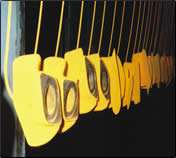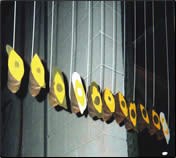Attractive Proposition
Magnetic masking can save time and money
#masking
In this era of continuous improvement and cost reduction, nearly any possible way to save time and money in manufacturing is explored. If that effort also can reduce waste disposal concerns, so much the better.
According to The Electrodyne Co. Inc. (Batavia, OH), one technology with the potential to do both is magnetic masking for ferrous parts.
Featured Content
The company’s flexible Plastalloy rubber-bonded strontium ferrite magnets can be bent, twisted and flexed without loss of magnetic energy, allowing finishers to produce custom masks for ferrous parts. The flexible magnet products are produced as sheets, strips, and die-cut shapes, and are available with a pressure-sensitive adhesive. Electrodyne says the ferrite magnets have plenty of holding power for masking applications, and are certified for automotive underhood and internal engine applications, so they should withstand powder curing cycles.
One finishing company that increased masking productivity using magnets is Advanced Finishing USA (Fairview, PA). Advanced Finishing eliminated time formerly spent taping each part and then removing the tape after powder coating and curing. Applying a magnetic mask saves the company an average of 30 sec per part; assuming a production run of 2,000 parts per month at standard labor rates, president and owner Greg Yahn estimates a cost savings of 20% per part using the magnets.
Another significant benefit to using magnets is that they are reusable. Yahn figures that they can be used 30–40 times, which eliminates a lot of waste tape and associated disposal concerns.
Advanced Finishing purchases the high-energy Plastalloy magnets as sheet stock. Sheets, which are available in widths to nine inch and lengths up to 100 ft, allow Advanced Finishing employees to custom-cut the magnets to particular sizes to suit their parts.
After curing, magnets are removed and cleaned using a blow-off nozzle on a compressed air line. The lead-free Plastalloy magnet material is ROHS- and EN71-compliant, making it suitable for environmentally sensitive applications.
At Advanced Finishing, use of magnets for masking ferrous parts yields a noticeable bottom line effect. Reduced labor input results in lower cost per part, and disposal fees for used tape are minimized. Improved product quality and appearance are harder to quantify, but important nonetheless.
Success in the masking application has Yahn pondering other potential uses for the flexible magnets. “Our experience with magnetic masking has opened our eyes to what can be done with a material that we had not considered before,” he says. “After our initial success, we’re thinking of magnets in a whole new way.” One possible product Yahn is considering is a line of decorative magnets with a wood-grain appearance.
RELATED CONTENT
-
Coatings Drive Electric Vehicles Further
Electric vehicle batteries depend on coatings to maintain optimal temperatures, reduce the risk of fire damage and electrical interference, and more.
-
Measuring the Surface Area of Fasteners
How do you measure the surface area of a threaded fastener? How much coating would you put on it? How thick of a coating? What about non-threaded fasteners? The U.S. Department of Agriculture’s Forest Service, of all people, may have come up with the solution for those pondering how to coat sometimes-difficult small pieces using computer imaging and software to compute the area.
-
Salt Spray Vs. Cyclic Corrosion Tests
Joseph Subda, ecoat specialist for Axalta Coating Systems, explains the difference between these two corrosion resistance tests.




















